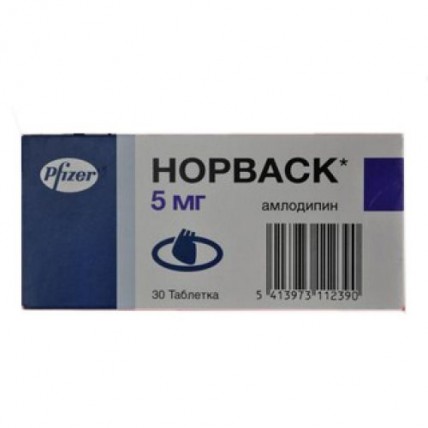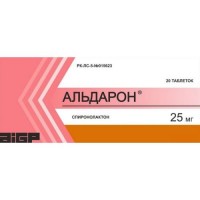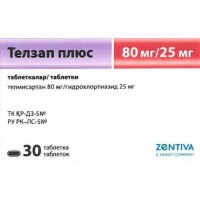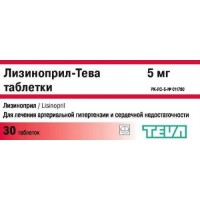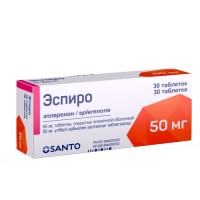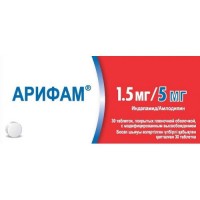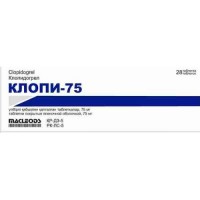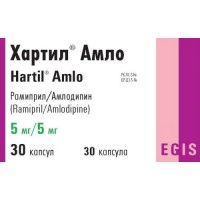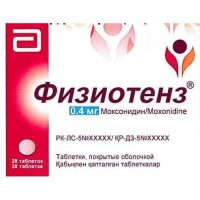Norvasc 5 mg (30 tablets)
- $41.80
The instruction for medical use
of Norvask® medicine
the Trade name
of Norvask®
the International unlicensed
name Amlodipin Lekarstvennaya a form
of the Tablet of 5 mg and 10 mg
Structure
One tablet contains
active agent - an amlodipin besilat in a dose, equivalent 5 and 10 mg of an amlodipin, respectively,
excipients: fine-crystalline cellulose, calcium hydrophosphate anhydrous, sodium starch glycollate type A, magnesium stearate.
The description
of the Tablet of 5 mg - white or almost white tablets in the form of an emerald (an octahedron with the uneven parties) from a logo of Pfizer on one party and AML-5 - on another.
Tablets of 10 mg - white or almost white tablets in the form of an emerald (an octahedron with the uneven parties) from a logo of Pfizer on one party and AML-10 - on another.
Pharmacotherapeutic group
Selection blockers of calcium channels, dihydropyridine derivatives.
The code of automatic telephone exchange C08CA01
the Pharmacological
Pharmacokinetics Later properties of intake in therapeutic doses amlodipin is well absorbed, reaching the maximum concentration in blood in 6-12 hours after reception. The absolute bioavailability is 64 - 80%. The volume of distribution is equal to about 21 l/kg. Communication with proteins of blood plasma makes about 97.5%. Meal does not influence absorption of an amlodipin, gets through a blood-brain barrier.
Elimination half-life (T1/2) makes about 35 - 50 hours of blood plasma that corresponds to prescribing of drug once a day. Stable equilibrium concentration in blood plasma is reached in 7-8 days of constant reception of an amlodipin, it is metabolized in a liver with formation of inactive metabolites, 10% of initial drug and 60% of metabolites are removed with urine. Removal with breast milk is unknown. During a hemodialysis it is not removed.
A pharmacodynamics
of Norvask® - derivative dihydropyridine. Contacting dihydropyridinic receptors, blocks 'slow' calcium channels, inhibits transmembrane transition of calcium in cells of an unstriated muscle of heart and vessels (more – in smooth muscle cells of vessels, than in cardiomyocytes). Renders hypotensive and anti-anginal effect.
The mechanism of hypotensive action Norvaska® is caused by the direct weakening impact on unstriated muscles of vessels.
Норваск® reduces myocardium ischemia the next two ways:
1. expands peripheral arterioles and, thus, reduces the general peripheric resistance (afterload), at the same time heart rate practically does not change that gives a ksnizheniya of consumption of energy and need of a myocardium for oxygen.
2. expands coronary and peripheral arteries and arterioles both in normal, and in ischemic zones of a myocardium that increases intake of oxygen in a myocardium at sick with a vazospasticheskoystenokardiya (Printsmetal's stenocardia) also prevents development of the coronary spasm caused by smoking.
At patients with arterial hypertension the single daily dose of Norvaska® provides a lowering of arterial pressure (ABP) for 24 hours (as in situation 'lying' and 'standing'). Thanks to the slow beginning of action amlodipin does not cause sharp decrease in the ABP.
At patients with stenocardia the single daily dose of drug increases tolerance to physical activity, delays development of an attack of stenocardia and depression of a segment of ST (on 1 mm) against the background of physical activity, reduces the frequency of attacks of stenocardia and consumption of nitroglycerine.
At the patients with cardiovascular diseases (including coronary atherosclerosis with defeat of one vessel and to a stenosis of the 3rd and more arteries and atherosclerosis of carotids) who had a myocardial infarction, chrezkozhny transluminal angioplasty of coronary arteries (TLP) or having stenocardia, use of Norvaska® prevents development of a thickening erotic-medii of carotids. Also use of Norvaska® considerably reduces lethality from the cardiovascular reasons, a myocardial infarction, stroke, TLP, aortocoronary shunting, leads to decrease in number of hospitalization concerning unstable stenocardia and progressing of the chronic heart failure (CHF), reduces the frequency of the interventions directed to restoration of a coronary blood-groove.
Indications
- arterial hypertension (both in monotherapy, and in combination with other antihypertensives)
- stable stenocardia and vasospastic stenocardia (Printsmetal's stenocardia) (both in monotherapy, and in combination with other anti-anginal means).
Inside, once a day, washing down a route of administration and doses with the necessary volume of water (100 ml).
In arterial hypertension and stenocardia the usual initial dose makes 5 mg, depending on individual reaction of the patient it can be increased to maximum - 10 mg.
Use for elderly people. It is recommended to apply in usual doses, change of a dose of drug is not required.
Use in a renal failure. It is recommended to apply in usual doses, however it is necessary to consider possible insignificant increase in T1/2.
Change of the mode of dosing of Norvaska® at simultaneous use of thiazide diuretics, beta blockers or inhibitors of the angiotensin-converting enzyme (ACE) is not required.
The course of treatment is established by the attending physician.
Use for children (6-17 years)
the Recommended antihypertensive oral dose for children makes from 2.5 to 5 mg once a day. Doses over 5 mg a day were not investigated for this population of patients.
The effect of Norvaska® on arterial blood pressure at children under 6 years is unknown.
Side effects
- peripheral hypostases (anklebones and feet), heartbeat, excessive decrease in the ABP, disturbance of a heart rhythm (including bradycardia, ventricular tachycardia and atrial fibrillation), thorax pains
- migraine, development or aggravation of heart failure, orthostatic hypotension, a vasculitis, a myocardial infarction
- arthralgias, myalgias, arthrosis, a myasthenia
- myotonia, a dorsodynia
- feeling of heat and 'inflows' to the person, increased fatigue, dizziness, a headache, drowsiness, an indisposition, a syncope, the increased sweating, 'cold' sweat, a fever
- hypesthesias, paresthesias, peripheral neuropathy, a tremor, insomnia, lability of mood, unusual dreams, nervousness, a depression, alarm, spasms, apathy, agitation, an ataxy, amnesia
- dryness in a mouth, increase in appetite, a food faddism, thirst, nausea, vomiting, a constipation, a meteorism, dyspepsia, diarrhea, anorexia, a hyperplasia of gums, an abdominal cavity pain
- a hyperbilirubinemia, jaundice (usually cholestatic), increase in activity of 'hepatic' transaminases
- gastritis, pancreatitis, hepatitis
- a Werlhof's disease, nasal bleeding
- a leukopenia, thrombocytopenia
- a hyperglycemia
- short wind, rhinitis, cough
- the speeded-up urination, urodynia, a nocturia, a dysuria, a polyuria
- impotence
- a skin itching, rash, a Quincke's disease, a multiformny erythema, a small tortoiseshell
- an alopecia, 'ring' in ears, a gynecomastia, increase/decrease in body weight
- disorders of vision, a diplopia, accommodation disturbance, a xerophthalmia, conjunctivitis, eye pain
- dermatitis, a parosmiya, a xerodermia, disturbance of xanthopathy
of the Contraindication
- hypersensitivity to an amlodipin and other derivatives of dihydropyridine and also to the excipients which are a part of drug
- heavy arterial hypotension
With care appoint to patients with a liver failure, HSN of not ischemic etiology of the III-IV class, an aortal stenosis, an acute
myocardial infarction (and within 1 month after it), aged up to 18 years (the efficiency and safety are definitely not established).
As well as when assigning other BMKK it is necessary to be careful against the background of reception of an amlodipin by patients with a sick sinus syndrome, a mitral stenosis, a hypertrophic subaortic stenosis, arterial hypotension.
Medicinal interactions
Inhibitors of microsomal oxidation can increase concentration of an amlodipin in plasma, enhancing risk of side effects, and inductors of microsomal enzymes of a liver - to reduce.
Cimetidinum: at simultaneous use of an amlodipin with Cimetidinum the pharmacokinetics of an amlodipin does not change.
Grapefruit juice: the concomitant use of grapefruit or grapefruit juice and an amlodipin is not recommended as the bioavailability can increase that will lead to strengthening of hypotensive effect of an amlodipin.
Unlike other BMKK of clinically significant interaction of drug Norvask (III generation of BMKK) it was not revealed at combined use with non-steroidal anti-inflammatory drugs (NPVP), especially indometacin.
Strengthening of anti-anginal and hypotensive action of BMKK at combined use with thiazide and 'loopback' diuretics, verapamil, APF inhibitors, beta blockers and nitrates and also increase in their hypotensive action at combined use with alfa1-adrenoblockers, neuroleptics is possible.
Though when studying the drug Norvask® of negative inotropic effect usually did not observe, nevertheless, some BMKK can enhance the significant negative inotropic effect of the antiarrhytmic drugs causing lengthening of an interval of QT (for example, Amiodaronum and quinidine).
At combined use of BMKK (for Norvaska® the data are absent) with drugs of lithium possibly strengthening of manifestation of their neurotoxicity (nausea, vomiting, diarrhea, an ataxy, a tremor, sonitus).
Amlodipin does not influence extent of linking with proteins of blood plasma of digoxin, Phenytoinum, warfarin and indometacin.
Aluminum/magnesium the containing antacids: their single dose has no significant effect on pharmacokinetics of an amlodipin.
Sildenafil (Viagra): single dose of a sildenafil of 100 mg at patients with essential hypertensia does not influence parameters of pharmacokinetics of an amlodipin.
Atorvastatin: repeated use of an amlodipin in a dose of 10 mg and an atorvastatina in a dose of 80 mg is not followed by significant changes in indicators of pharmacokinetics of an atorvastatin.
Digoxin: at simultaneous use of an amlodipin with digoxin the serumal levels and renal clearance of digoxin do not change.
Warfarin: amlodipin does not influence the changes of a prothrombin time caused by warfarin.
Cyclosporine: amlodipin does not cause significant changes in pharmacokinetics of cyclosporine.
Special instructions
At treatment of arterial hypertension of Norvask® it can be applied in a combination with thiazide diuretics, alpha and beta blockers, APF inhibitors, nitrates of the prolonged action, sublingual nitroglycerine, NPVP, antibiotics and oral hypoglycemic means.
For treatment of stenocardia of Norvask® it is possible to appoint as means of monotherapy or in a combination with other anti-anginal means, including at the patients refractory to treatment with nitrates and/or beta blockers in adequate doses.
Норваск® has no adverse impact on a metabolism and lipids of blood plasma and it can be applied at treatment of patients with bronchial asthma, diabetes and gout. To patients of low growth and patients with the profound abnormal liver function the smaller dosage can be required by patients with small body weight.
During treatment the control of body weight and observation at the stomatologist is necessary (for prevention of morbidity, bleeding and a hyperplasia of gums).
Pregnancy and the period of a lactation
Safety of use of Norvaska® during pregnancy and feeding by a breast is not established therefore use during pregnancy is possible only in case the advantage for mother exceeds risk for a fruit and the newborn.
Features of influence of medicine on ability to run the vehicle or potentially dangerous mechanisms
Owing to possible excessive decrease in the ABP, development of dizziness, drowsiness, etc. in by-effects, it is necessary to show consideration for individual effect of drug in the specified situations, especially in an initiation of treatment and at change of the mode of dosing.
Overdose
Symptoms: the significant decrease in the ABP with possible development of reflex tachycardia and an excessive peripheral vazodilatation (there is a probability of appearance of the profound and persistent arterial hypotension, including with development of shock and a lethal outcome).
Treatment: prescribing of activated carbon (especially in the first 2 hours after overdose), gastric lavage (in some cases), giving of sublime situation to extremities, the actions directed to active maintenance of function of a cardiovascular system, monitoring of indicators of cardiac performance and lungs, control of volume of the circulating blood and a diuresis.
For restoration of a tone of vessels and the ABP if there are no contraindications, there can be useful a use of vasoconstrictive drugs (dopamine, noradrenaline). Use intravenous administration of a gluconate of calcium. As Norvask® substantially contacts serum proteins - the hemodialysis is inefficient.
A form of release and packing
of the Tablet on 5 and 10 mg. On 10 tablets in blister strip packaging from polyvinylchloride / aluminum foil, on the 3rd blister strip packagings together with the instruction for use in a cardboard pack.
To Store storage conditions at a temperature not above +25 °C.
To store out of children's reach!
A period of storage
4 years
not to use drug upon termination of the expiration date specified on packing.
Prescription status
According to the prescription
Proizvoditel Pfayzer Manufakturing Doychland GmbH Heinrich Mack Strasse 35 D-89257 Illertissen, Germany
the Address of the organization accepting in the territory of the Republic of Kazakhstan claims from consumers on quality of this product:
Representative office of Pfizer HCP Corporation (USA) Almaty, Abylay Ave. of the khan, 141
ph. (727) 272-27-01
fax (727) 272-04-06
To develop
of Norvask® medicine
the Trade name
of Norvask®
the International unlicensed
name Amlodipin Lekarstvennaya a form
of the Tablet of 5 mg and 10 mg
Structure
One tablet contains
active agent - an amlodipin besilat in a dose, equivalent 5 and 10 mg of an amlodipin, respectively,
excipients: fine-crystalline cellulose, calcium hydrophosphate anhydrous, sodium starch glycollate type A, magnesium stearate.
The description
of the Tablet of 5 mg - white or almost white tablets in the form of an emerald (an octahedron with the uneven parties) from a logo of Pfizer on one party and AML-5 - on another.
Tablets of 10 mg - white or almost white tablets in the form of an emerald (an octahedron with the uneven parties) from a logo of Pfizer on one party and AML-10 - on another.
Pharmacotherapeutic group
Selection blockers of calcium channels, dihydropyridine derivatives.
The code of automatic telephone exchange C08CA01
the Pharmacological
Pharmacokinetics Later properties of intake in therapeutic doses amlodipin is well absorbed, reaching the maximum concentration in blood in 6-12 hours after reception. The absolute bioavailability is 64 - 80%. The volume of distribution is equal to about 21 l/kg. Communication with proteins of blood plasma makes about 97.5%. Meal does not influence absorption of an amlodipin, gets through a blood-brain barrier.
Elimination half-life (T1/2) makes about 35 - 50 hours of blood plasma that corresponds to prescribing of drug once a day. Stable equilibrium concentration in blood plasma is reached in 7-8 days of constant reception of an amlodipin, it is metabolized in a liver with formation of inactive metabolites, 10% of initial drug and 60% of metabolites are removed with urine. Removal with breast milk is unknown. During a hemodialysis it is not removed.
A pharmacodynamics
of Norvask® - derivative dihydropyridine. Contacting dihydropyridinic receptors, blocks 'slow' calcium channels, inhibits transmembrane transition of calcium in cells of an unstriated muscle of heart and vessels (more – in smooth muscle cells of vessels, than in cardiomyocytes). Renders hypotensive and anti-anginal effect.
The mechanism of hypotensive action Norvaska® is caused by the direct weakening impact on unstriated muscles of vessels.
Норваск® reduces myocardium ischemia the next two ways:
1. expands peripheral arterioles and, thus, reduces the general peripheric resistance (afterload), at the same time heart rate practically does not change that gives a ksnizheniya of consumption of energy and need of a myocardium for oxygen.
2. expands coronary and peripheral arteries and arterioles both in normal, and in ischemic zones of a myocardium that increases intake of oxygen in a myocardium at sick with a vazospasticheskoystenokardiya (Printsmetal's stenocardia) also prevents development of the coronary spasm caused by smoking.
At patients with arterial hypertension the single daily dose of Norvaska® provides a lowering of arterial pressure (ABP) for 24 hours (as in situation 'lying' and 'standing'). Thanks to the slow beginning of action amlodipin does not cause sharp decrease in the ABP.
At patients with stenocardia the single daily dose of drug increases tolerance to physical activity, delays development of an attack of stenocardia and depression of a segment of ST (on 1 mm) against the background of physical activity, reduces the frequency of attacks of stenocardia and consumption of nitroglycerine.
At the patients with cardiovascular diseases (including coronary atherosclerosis with defeat of one vessel and to a stenosis of the 3rd and more arteries and atherosclerosis of carotids) who had a myocardial infarction, chrezkozhny transluminal angioplasty of coronary arteries (TLP) or having stenocardia, use of Norvaska® prevents development of a thickening erotic-medii of carotids. Also use of Norvaska® considerably reduces lethality from the cardiovascular reasons, a myocardial infarction, stroke, TLP, aortocoronary shunting, leads to decrease in number of hospitalization concerning unstable stenocardia and progressing of the chronic heart failure (CHF), reduces the frequency of the interventions directed to restoration of a coronary blood-groove.
Indications
- arterial hypertension (both in monotherapy, and in combination with other antihypertensives)
- stable stenocardia and vasospastic stenocardia (Printsmetal's stenocardia) (both in monotherapy, and in combination with other anti-anginal means).
Inside, once a day, washing down a route of administration and doses with the necessary volume of water (100 ml).
In arterial hypertension and stenocardia the usual initial dose makes 5 mg, depending on individual reaction of the patient it can be increased to maximum - 10 mg.
Use for elderly people. It is recommended to apply in usual doses, change of a dose of drug is not required.
Use in a renal failure. It is recommended to apply in usual doses, however it is necessary to consider possible insignificant increase in T1/2.
Change of the mode of dosing of Norvaska® at simultaneous use of thiazide diuretics, beta blockers or inhibitors of the angiotensin-converting enzyme (ACE) is not required.
The course of treatment is established by the attending physician.
Use for children (6-17 years)
the Recommended antihypertensive oral dose for children makes from 2.5 to 5 mg once a day. Doses over 5 mg a day were not investigated for this population of patients.
The effect of Norvaska® on arterial blood pressure at children under 6 years is unknown.
Side effects
- peripheral hypostases (anklebones and feet), heartbeat, excessive decrease in the ABP, disturbance of a heart rhythm (including bradycardia, ventricular tachycardia and atrial fibrillation), thorax pains
- migraine, development or aggravation of heart failure, orthostatic hypotension, a vasculitis, a myocardial infarction
- arthralgias, myalgias, arthrosis, a myasthenia
- myotonia, a dorsodynia
- feeling of heat and 'inflows' to the person, increased fatigue, dizziness, a headache, drowsiness, an indisposition, a syncope, the increased sweating, 'cold' sweat, a fever
- hypesthesias, paresthesias, peripheral neuropathy, a tremor, insomnia, lability of mood, unusual dreams, nervousness, a depression, alarm, spasms, apathy, agitation, an ataxy, amnesia
- dryness in a mouth, increase in appetite, a food faddism, thirst, nausea, vomiting, a constipation, a meteorism, dyspepsia, diarrhea, anorexia, a hyperplasia of gums, an abdominal cavity pain
- a hyperbilirubinemia, jaundice (usually cholestatic), increase in activity of 'hepatic' transaminases
- gastritis, pancreatitis, hepatitis
- a Werlhof's disease, nasal bleeding
- a leukopenia, thrombocytopenia
- a hyperglycemia
- short wind, rhinitis, cough
- the speeded-up urination, urodynia, a nocturia, a dysuria, a polyuria
- impotence
- a skin itching, rash, a Quincke's disease, a multiformny erythema, a small tortoiseshell
- an alopecia, 'ring' in ears, a gynecomastia, increase/decrease in body weight
- disorders of vision, a diplopia, accommodation disturbance, a xerophthalmia, conjunctivitis, eye pain
- dermatitis, a parosmiya, a xerodermia, disturbance of xanthopathy
of the Contraindication
- hypersensitivity to an amlodipin and other derivatives of dihydropyridine and also to the excipients which are a part of drug
- heavy arterial hypotension
With care appoint to patients with a liver failure, HSN of not ischemic etiology of the III-IV class, an aortal stenosis, an acute
myocardial infarction (and within 1 month after it), aged up to 18 years (the efficiency and safety are definitely not established).
As well as when assigning other BMKK it is necessary to be careful against the background of reception of an amlodipin by patients with a sick sinus syndrome, a mitral stenosis, a hypertrophic subaortic stenosis, arterial hypotension.
Medicinal interactions
Inhibitors of microsomal oxidation can increase concentration of an amlodipin in plasma, enhancing risk of side effects, and inductors of microsomal enzymes of a liver - to reduce.
Cimetidinum: at simultaneous use of an amlodipin with Cimetidinum the pharmacokinetics of an amlodipin does not change.
Grapefruit juice: the concomitant use of grapefruit or grapefruit juice and an amlodipin is not recommended as the bioavailability can increase that will lead to strengthening of hypotensive effect of an amlodipin.
Unlike other BMKK of clinically significant interaction of drug Norvask (III generation of BMKK) it was not revealed at combined use with non-steroidal anti-inflammatory drugs (NPVP), especially indometacin.
Strengthening of anti-anginal and hypotensive action of BMKK at combined use with thiazide and 'loopback' diuretics, verapamil, APF inhibitors, beta blockers and nitrates and also increase in their hypotensive action at combined use with alfa1-adrenoblockers, neuroleptics is possible.
Though when studying the drug Norvask® of negative inotropic effect usually did not observe, nevertheless, some BMKK can enhance the significant negative inotropic effect of the antiarrhytmic drugs causing lengthening of an interval of QT (for example, Amiodaronum and quinidine).
At combined use of BMKK (for Norvaska® the data are absent) with drugs of lithium possibly strengthening of manifestation of their neurotoxicity (nausea, vomiting, diarrhea, an ataxy, a tremor, sonitus).
Amlodipin does not influence extent of linking with proteins of blood plasma of digoxin, Phenytoinum, warfarin and indometacin.
Aluminum/magnesium the containing antacids: their single dose has no significant effect on pharmacokinetics of an amlodipin.
Sildenafil (Viagra): single dose of a sildenafil of 100 mg at patients with essential hypertensia does not influence parameters of pharmacokinetics of an amlodipin.
Atorvastatin: repeated use of an amlodipin in a dose of 10 mg and an atorvastatina in a dose of 80 mg is not followed by significant changes in indicators of pharmacokinetics of an atorvastatin.
Digoxin: at simultaneous use of an amlodipin with digoxin the serumal levels and renal clearance of digoxin do not change.
Warfarin: amlodipin does not influence the changes of a prothrombin time caused by warfarin.
Cyclosporine: amlodipin does not cause significant changes in pharmacokinetics of cyclosporine.
Special instructions
At treatment of arterial hypertension of Norvask® it can be applied in a combination with thiazide diuretics, alpha and beta blockers, APF inhibitors, nitrates of the prolonged action, sublingual nitroglycerine, NPVP, antibiotics and oral hypoglycemic means.
For treatment of stenocardia of Norvask® it is possible to appoint as means of monotherapy or in a combination with other anti-anginal means, including at the patients refractory to treatment with nitrates and/or beta blockers in adequate doses.
Норваск® has no adverse impact on a metabolism and lipids of blood plasma and it can be applied at treatment of patients with bronchial asthma, diabetes and gout. To patients of low growth and patients with the profound abnormal liver function the smaller dosage can be required by patients with small body weight.
During treatment the control of body weight and observation at the stomatologist is necessary (for prevention of morbidity, bleeding and a hyperplasia of gums).
Pregnancy and the period of a lactation
Safety of use of Norvaska® during pregnancy and feeding by a breast is not established therefore use during pregnancy is possible only in case the advantage for mother exceeds risk for a fruit and the newborn.
Features of influence of medicine on ability to run the vehicle or potentially dangerous mechanisms
Owing to possible excessive decrease in the ABP, development of dizziness, drowsiness, etc. in by-effects, it is necessary to show consideration for individual effect of drug in the specified situations, especially in an initiation of treatment and at change of the mode of dosing.
Overdose
Symptoms: the significant decrease in the ABP with possible development of reflex tachycardia and an excessive peripheral vazodilatation (there is a probability of appearance of the profound and persistent arterial hypotension, including with development of shock and a lethal outcome).
Treatment: prescribing of activated carbon (especially in the first 2 hours after overdose), gastric lavage (in some cases), giving of sublime situation to extremities, the actions directed to active maintenance of function of a cardiovascular system, monitoring of indicators of cardiac performance and lungs, control of volume of the circulating blood and a diuresis.
For restoration of a tone of vessels and the ABP if there are no contraindications, there can be useful a use of vasoconstrictive drugs (dopamine, noradrenaline). Use intravenous administration of a gluconate of calcium. As Norvask® substantially contacts serum proteins - the hemodialysis is inefficient.
A form of release and packing
of the Tablet on 5 and 10 mg. On 10 tablets in blister strip packaging from polyvinylchloride / aluminum foil, on the 3rd blister strip packagings together with the instruction for use in a cardboard pack.
To Store storage conditions at a temperature not above +25 °C.
To store out of children's reach!
A period of storage
4 years
not to use drug upon termination of the expiration date specified on packing.
Prescription status
According to the prescription
Proizvoditel Pfayzer Manufakturing Doychland GmbH Heinrich Mack Strasse 35 D-89257 Illertissen, Germany
the Address of the organization accepting in the territory of the Republic of Kazakhstan claims from consumers on quality of this product:
Representative office of Pfizer HCP Corporation (USA) Almaty, Abylay Ave. of the khan, 141
ph. (727) 272-27-01
fax (727) 272-04-06
To develop
